This is a free fortnightly newsletter about the New Zealand Net. If you would like to be notified by email when a new edition is published, please contact ZL1NZ.
Browse our Newsletter Archive and List of Net Tips.
Featured key
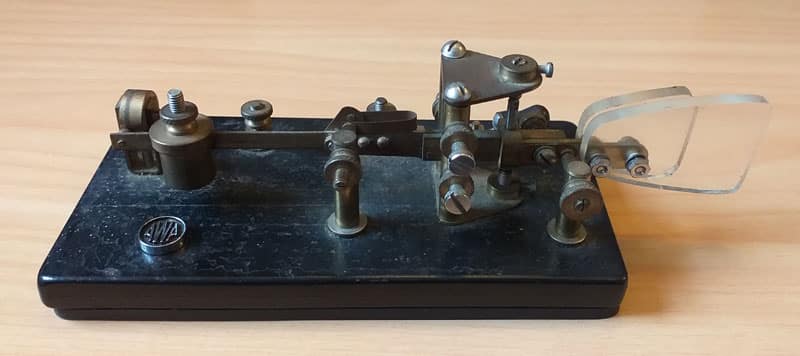
AWA New Zealand bug. Photo: ZL1NZ
This extremely rare bug, similar in design to a Vibroplex Zephyr, was made in the Wellington, New Zealand workshops of Amalgamated Wireless Australasia (AWA).
It is made of brass components mounted on a steel base with what appears to be a japanned finish. The original owner of the key pictured here is Mike ZL2BBS, who recalls buying it from the AWA workshop manager, Morris Toomer.
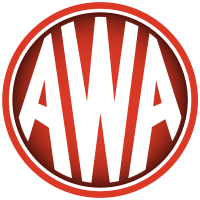 “I joined AWA in 1973 when they had a factory in Adelaide Road, Wellington. There were several licensed amateurs on the staff at that time, although most of them were VHF-only. Morris told me he had made a handful of keys for the staff as a perk job a couple of years previously. I can only recall one staff member who was interested in CW, Ray Smith ZL2AQV (SK) so I’m guessing there were only three or four of these keys produced. They weren’t made for sale, and I’ve never seen another one.”
“I joined AWA in 1973 when they had a factory in Adelaide Road, Wellington. There were several licensed amateurs on the staff at that time, although most of them were VHF-only. Morris told me he had made a handful of keys for the staff as a perk job a couple of years previously. I can only recall one staff member who was interested in CW, Ray Smith ZL2AQV (SK) so I’m guessing there were only three or four of these keys produced. They weren’t made for sale, and I’ve never seen another one.”
For more information on this key, visit the NZ Morse Key Directory.
See the video below for a demonstration of the AWA bug’s impressive slow-speed performance.
* If you have an interesting key for this feature, please send me a nice clear photo and a few words describing it.
Quick notes
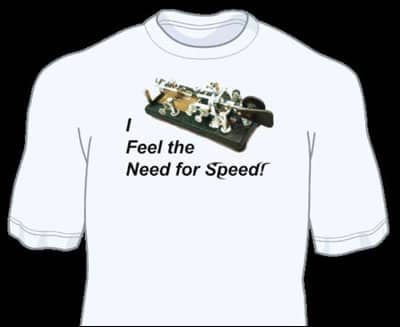 A T-shirt featuring an early Vibroplex Blue Racer looks like the perfect gift for your favourite bug operator. I saw it on the Etsy website while looking at some old keys for sale. The Blue Racer is reputed to be one of the fastest Vibroplex bugs.
A T-shirt featuring an early Vibroplex Blue Racer looks like the perfect gift for your favourite bug operator. I saw it on the Etsy website while looking at some old keys for sale. The Blue Racer is reputed to be one of the fastest Vibroplex bugs.
Speaking of speed, in NZ Net News 84 we featured the Begali HST single-lever paddle. HST refers to the High Speed Telegraphy contest. And now there is a brand new HST on the desk of one of our net members (a lucky guy). See his review of this beautiful single-lever paddle later in this edition.
The latest Sangster Shield results include lots of familiar callsigns. Net members Barry ZL2LN, Graeme ZL2TE, Gerard ZL2GVA and Bruce ZL1BWG did well, with Barry winning the Arthur Stephens (South Island) Trophy for the tenth time! The overall winner of this QRP CW contest was Paul ZL1PC, who has been an occasional visitor to NZ Net. Full results.
The ZL Sprints weekly contests are back, every Tuesday evening on 80m. Gerard ZL2GVA has been participating in the CW QRP section. The Sprints are from 20:00 to 20:29. (There is also an SSB section in the following half hour.) Contest rules.
A visit to VK4PN

Steve ZL2KE and Sava VK4PN in Sava’s shack
By Steve ZL2KE
With the borders finally open between New Zealand and Australia my wife and I booked flights to see family. After completing the online Covid vaccination declarations and confirming our stays with family in Sydney, Newcastle and Brisbane, I sent an email to Sava VK4PN to say that we would be in Brisbane. We only had one free day, 4 July, did not have a car, and knew that Sava lived a good distance from where we were staying, so I thought there would be a slim chance of having an eyeball QSO with our VK4 NZ Net member. However Sava replied quickly to say that he would pick us up and take us to his home!
In between our family visits in Newcastle and Brisbane, we had a short holiday on the Gold Coast and from there I telephoned Sava. We had a most interesting discussion and it was a pleasure to find that Sava was exceptionally friendly and considerate (I do believe that we CW ops tend to be this way, ha!). We found that we had a bit of an old connection: in 1971 I was in Belgrade where Sava was living at the time (I was on my way to Sofia, Bulgaria to visit a CW op friend).
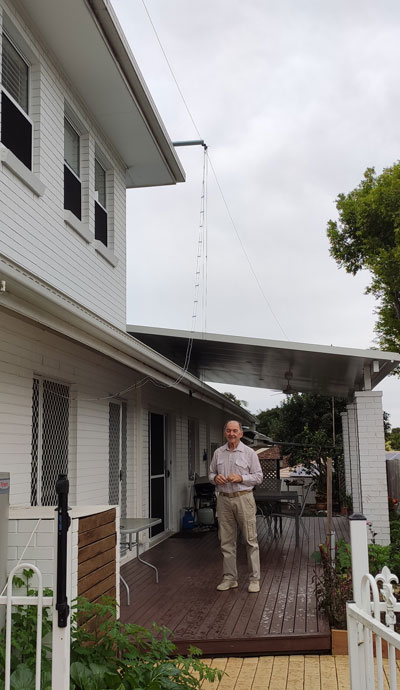 Sava said that he would pick us up at 10am from where we were staying in the Brisbane CBD and, impressively, he managed the city traffic to arrive within seconds of 10.00. During the 40-minute drive to his home, Sava acted as a tour guide telling us many interesting facts about Brisbane. His knowledge came from working in Brisbane for over 25 years.
Sava said that he would pick us up at 10am from where we were staying in the Brisbane CBD and, impressively, he managed the city traffic to arrive within seconds of 10.00. During the 40-minute drive to his home, Sava acted as a tour guide telling us many interesting facts about Brisbane. His knowledge came from working in Brisbane for over 25 years.
We were welcomed into his home by his XYL who had ANZAC biscuits and coffee for us, plus Australian flag serviettes. While our wives chatted about education, hospital work, and gardening, Sava showed me his shack and antenna. Situated on a small hill, he runs 50 watts into a homebrew centre-fed antenna.
Sava was an active member of the Sunshine Coast Amateur Radio Club and led members in various homebrew projects. His professional work was as technical supervisor for Queensland Railways radio communications. It was fascinating to hear many stories involving the railways and amateur radio.
During the trip back to Brisbane, Sava took us to the Mt Coot-tha Summit Lookout, a popular viewpoint. It was very windy and a cold 13°C – which was chilly for the locals as we noticed them wearing winter jackets even when it was 21°. Once again ‘tour guide’ Sava gave us a great commentary.
We feel grateful that our two weeks in Australia went without any problems, especially no Covid or influenza, and we have many happy family memories, plus the highlight of being with Sava.
The Amateur Radio Code of Conduct was written in 1928, then expanded in 2008 as a comprehensive document ‘Ethics and Operating Procedures for the Radio Amateur’. Included in these documents is the following: “The Amateur Radio Operator is FRIENDLY – operates slowly and patiently when requested; offers friendly advice and counsel to beginners; kind assistance, cooperation and consideration for the interests of others. These are the marks of the amateur spirit.” Personally, since 1963, I have found this to be true; rarely are there exceptions, especially among CW ops. VK4PN certainly exemplifies this. Thanks very much Sava for a great visit!
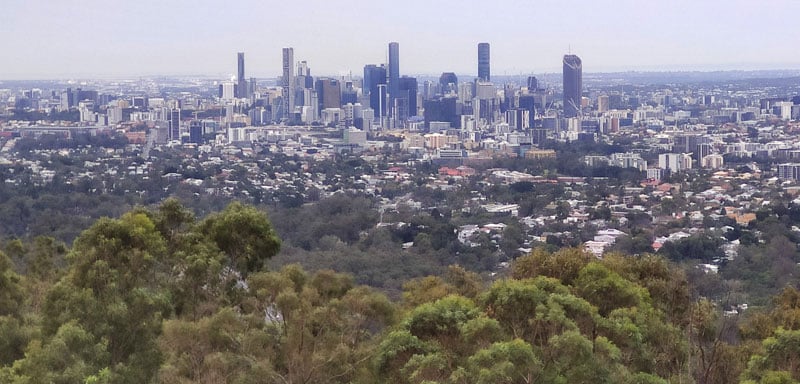
Brisbane, seen from Mt Coot-Tha
Photo flashback
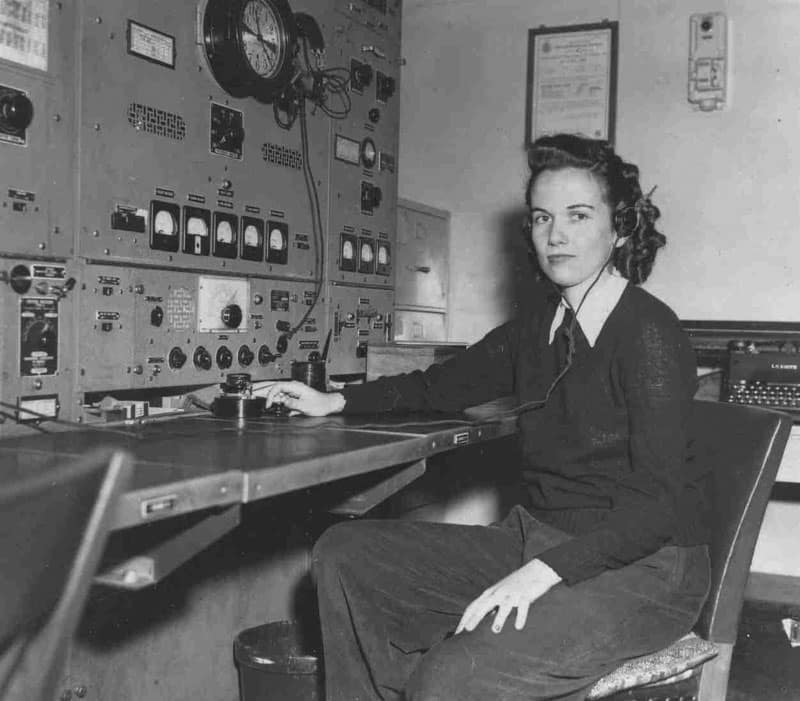
Olive Carroll, from Vancouver, sailed as Radio Officer aboard the Norwegian cargo ship MV Siranger LMMK from 1947 to 1950. At that time, women were not allowed as radio officers on Canadian vessels, but several joined Scandinavian ships. A talented writer, Olive told her story of life aboard Siranger in the book Deep Sea ‘Sparks’, which I highly recommend, and she also documented the careers of other female radio officers. After leaving the sea, Olive became an active radio amateur (CW, of course) and she currently holds the callsign VA6ERA at age 100. In this photo, Olive is seen in the radio room of Siranger, which was fitted with an RCA 4U console for HF and MF.
Net numbers

Here is the monthly net report, as transmitted during NZ Net on 1 Aug 2022.
NR36 R ZL1NZ 43/40 AUCKLAND 0900Z 1AUG22 = NZ NET = JULY QNI VK3DRQ 18 VK4PN 13 ZL1AJY 5 ZL1ANY 18 ZL1BWG 19 ZL1NZ 21 ZL1PX 6 ZL1RA 17 ZL2GD 18 ZL2GVA 19 ZL2KE 9 ZL2LN 11 ZL2TE 13 ZL3TK 21 ZL4CU 4 ZL4FZ 2 ZL4KX 10 TOTAL 224 QTC 89 = ZL1NZ
Unplanned antenna work
By Neil ZL1NZ
Yesterday morning, I was working in my home office when I heard a mighty crash. The neighbours were having two tall Washingtonia palms removed from their front yard and it sounded like a tree had hit our house on the way down.
One of our security cameras caught the event. Our house is on the left of the video, and there is a picket fence between our front yard and the neighbours’ driveway.
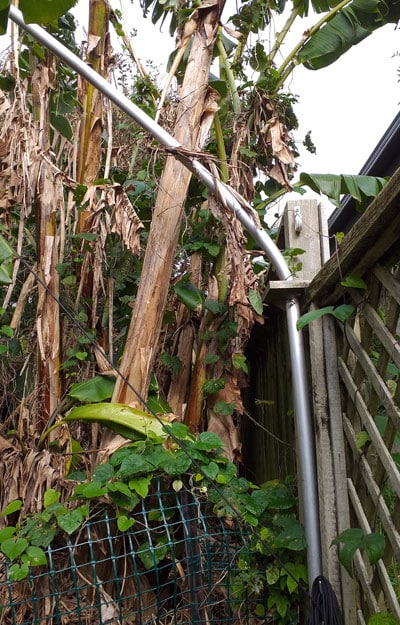 As you can see, the top of the tree didn’t fall straight down, but instead headed towards our property. I suppose those huge fronds have some aerodynamic properties and the tree top did a bit of flying. It destroyed a section of the fence (and narrowly missed the chap you can see standing in the driveway!).
As you can see, the top of the tree didn’t fall straight down, but instead headed towards our property. I suppose those huge fronds have some aerodynamic properties and the tree top did a bit of flying. It destroyed a section of the fence (and narrowly missed the chap you can see standing in the driveway!).
There was no damage to our house, BUT my 40m-long doublet aerial took the full weight of the tree top. Amazingly, the military surplus antenna wire did not break, nor did the recently replaced marine-grade rope. Even the fairly thin birch tree branch holding one end of the aerial survived. But the falling aerial pulled down two masts, bending them beyond redemption.
Fortunately, I had spare masts (doesn’t everyone?) so by 1600 hours the doublet was back in the air. Lost a day’s revenue-generating work, but I didn’t have to miss the NZ Net. It’s all about priorities, right?
Now, apparently I have to get the fence fixed.
Audio challenge
Our audio challenge this time is a clever radiogram from an NZ Net session in 2020. It’s a response to one of my trivia questions (which I cannot even remember). Your assignment is to tell me the three types of people mentioned in the text.
Please send your answer to me via radiogram, or via email if you don’t have propagation.
Answer to previous Audio Challenge
The message was: THIS YEARS NZART CONFERENCE WILL BE HELD IN WELLINGTON ON 10 AND 11 SEPTEMBER
Correct answers were received from VK3DRQ, ZL1ANY, ZL1AYN, ZL1BWG, ZL1RA, ZL2GVA, ZL2KE, ZL3TK and ZL4LDY.
New key at BWG
By Bruce ZL1BWG
I read about the HST key in NZ Net News 84, so will blame Neil for the subsequent purchase, because if he hadn’t shown it I would not have bought it!
However, I jumped from the frying pan into the fire, contacted Begali and, as they say, “the rest is history.”
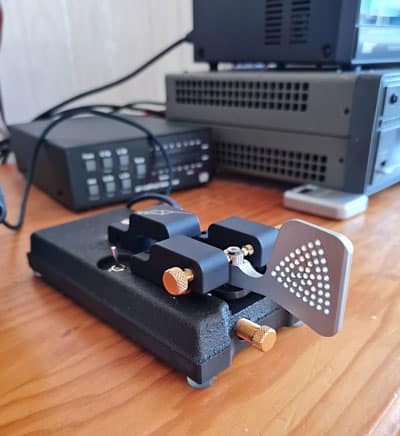 Bruna said that it would only take about a week to come from Italy to New Zealand, and she was pretty well right as it was about eight days. It was very well packed and both contact screws were wound in to eliminate any side play in the paddle during transit.
Bruna said that it would only take about a week to come from Italy to New Zealand, and she was pretty well right as it was about eight days. It was very well packed and both contact screws were wound in to eliminate any side play in the paddle during transit.
As for using the key, what a breeze. I had a good long ragchew for about an hour and a quarter the other night with a VK2, and experienced no fatigue in my right hand or fingers. Considering that I have fairly advanced arthritis in my hands, that is good going.
This key, being a single lever, cannot break into iambic mode, which at times I have a little bit of a habit of doing on dual-lever paddles, as sometimes I will close one before releasing the other.
As well, there is no problem with the key drifting around on the desk as it weights over 3 pounds (1.36 kg). There are four rubber feet and even if these do deteriorate, they can be unscrewed and replaced; they are not stick-on wonders.
The HST is supplied with a 3.5mm to 3.5mm lead about a metre long. One plug is right-angle and both plugs are gold plated. All in all a very nice key to use – and well worth “the cabbages.”
Video: AWA New Zealand bug
I have never seen a bug that will key as slowly as the AWA New Zealand bug. It will easily slow down to about 12wpm without additional weights or extensions to the pendulum. It makes a pretty good string of nice, clean dits too, far more then one would ever need.
Apologies for the low audio from my phone camera. My free video software wouldn’t let me boost it.
Advertising archive
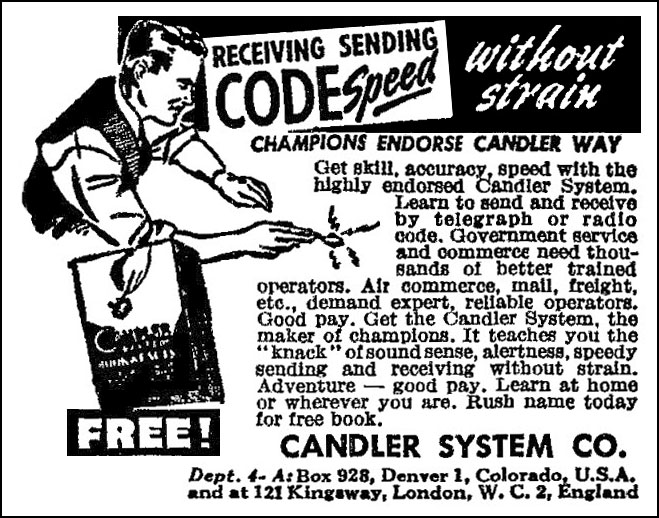
QST magazine, January 1949
Suggestions?
If you have suggestions on how to make the NZ Net better, or things you’d like to see covered in these updates, please contact ZL1NZ. You might even like to write something for the newsletter.
Thanks for reading, and I hope to hear you soon on the NZ Net!
—
Neil Sanderson ZL1NZ, Net Manager
New Zealand Net (NZ NET)
3535.0 kHz at 9pm NZT Mon-Fri




